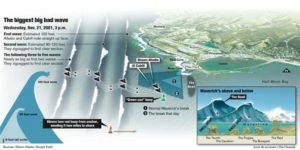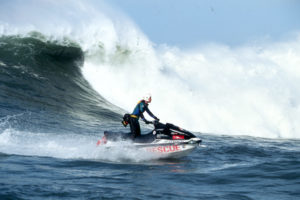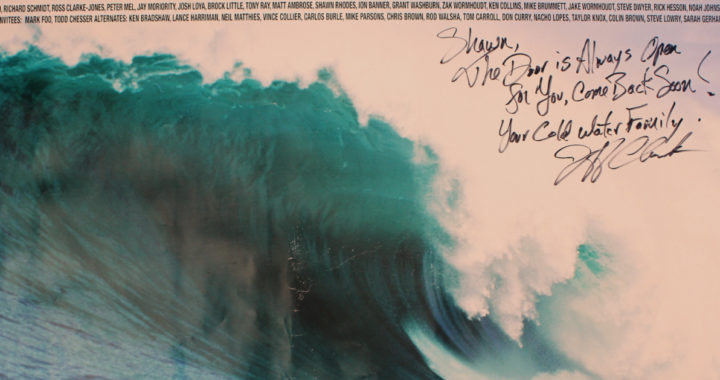FADING LA NINA
StormSurf.com clinical analysis of Storm #8 of the year 2001
Reference date: November 21, 2001
Storm #8 generated the largest swell on record. Beating out the huge Hawaiian El Nino swell of 1/28/98.
Forecast to be a rather local and moderate storm that was to track over buoy 46006 (SE Papa). Like Storm 1 in 1999, what actually hit was beyond imagination.
Days earlier 2 storms were forecast to move in quick succession into the Gulf of Alaska.
As expected, the first one developed and followed the forecast track. Generating a swell that started to hit the outer SE Papa buoy (46006) on 11/19 at 11 AM with seas in the 20-23 ft @ 17 secs.
This swell reached Mavericks the afternoon of November 20th with seas 13-14 ft @ 14-17 secs with swell 10.5 ft @ 15.5 secs, holding through the night. Nothing noteworthy but defiantly rideable at Mavericks. While the first storm took up residence in the Gulf and slowly faded. A second storm followed quickly in its tracks on November 19th.
It developed a small but relatively intense fetch area in its south quadrant with winds at 55-60 knots blowing due east. Carried by the Jetstream and fueled by the moisture left behind by the first storm. These winds found lots of traction at the ocean’s surface, already agitated from the earlier storm.

K38 at Mavericks
MAVERICKS
The new storm also tracked east at a very fast pace. Not allowing the developing seas to escape the influence of its winds, piling more wave energy on top of an already large swell (virtual fetch).
By the morning of 11/20 winds were still being recorded with speeds at 55-60 knots.
The northern component of the resulting swell hit buoy 46006 at 9 AM and held through 7 PM with seas ranging 38.5-41.9 ft @ 17-20 seconds. Very large but not off the scale.
Clearly, this buoy did not get hit with all the wave energy this storm had produced. With much of it passing south undetected. And buoy 46059 located 350 nautical miles off Pt. Reyes was out of service, it was ripped off the ocean floor from large swell activity. Further reducing the effectiveness of the normal early warning system.
Nearshore the situation got interesting. On the morning of 11/21, the swell from the first storm was still present at buoy 46012 (Half Moon Bay) with decoded swell at 12 ft @ 15 secs. As expected, by 10 AM the second swell started to build in with combined seas 16.4 ft and the new swell at 11.1 @ 20 secs and increasing rapidly.
The paddle-in crew was out cautiously catching some bombs as the swell jumped in size with each passing set. The tow teams waited in the channel for their chance to strike. By noon they got their chance as the last paddle surfers were cleaned out and increasing south winds took a toll on conditions.
Combined seas were 19.6 ft @ 20 secs with solid energy out to 25 secs and swell 14.1 ft @ 19 secs.
One hour later swell was up to 14.9 ft @ 19 secs. By now the tow teams were only shoulder hopping the huge sets that were pouring over the reef while south winds set up a strong northerly cross chop.
Even so, Carlos Burle managed to snag the biggest wave of the year, measured at 68 ft on the face.

Shawn working rescue at Mavericks
PEAK
The swell was interacting with the 15 second swell already present, creating huge waves breaking way outside the normal outermost reefs. By 2 PM the new swell was up to 16.3 ft @ 19 seconds, then up to 19.3 ft @ 21 second one hour later.
Shawn Alladio (K38) was out in the channel on a Jet Ski® at Mavericks and reported nearly being taken out by a set of waves. The largest being upwards of 100 ft. Based on the buoys, even larger waves followed after she made it safely to shore.
By 5 PM the largest decoded swell reading hit, with swell at 19.9 ft @ 19.4 secs and combined seas to 23.98 ft.
Whitewater was visible out to the horizon at most coastal locations. And longtime locals reporting breaks they had never seen were going off, but way beyond anything that would be classified as rideable.
Carlos Burle towed into a wave early in the swell of November 21, 2001 at Mavericks. Even larger and meaner waves broke that afternoon, with no one in sight.
Story posted here: http://stormsurf.com/page2/papers/history.html
______________________
Posted: June 23, 2019
Content Creator of Rescue Water Craft and Personal Water Craft boating international education standards: Shawn Alladio is the world’s foremost authority and leading subject matter expert. She cares most about her community and the culture surrounding the safety of event service providers and Rescue Water Craft operators, working hard and dedicated towards protecting their reputation, distributing safety information and continuing to train these amazing individuals to the highest standards of care.
__________
Have any questions? Join the Rescue Water Craft Association
and discover what your community is doing to modernize standards, safety and reduce liability!
Join the Rescue Water Craft Association
Use at your own risk. Please take a qualified Rescue Water Craft training course and maintain proper records and respect all the PWC, RWC, PPE, and gear OEM manufacturer warning labels and cautions.
